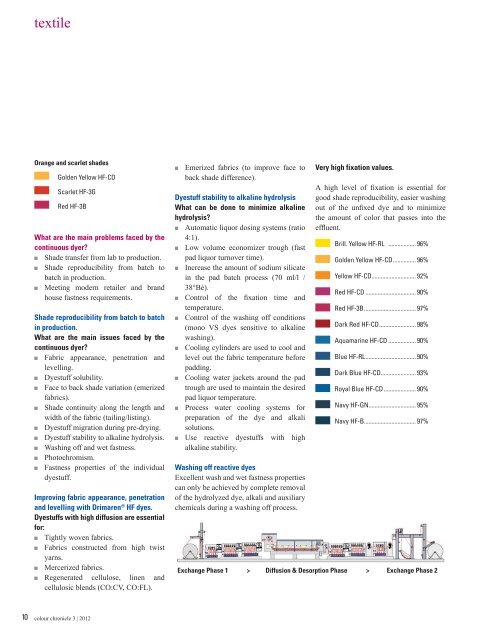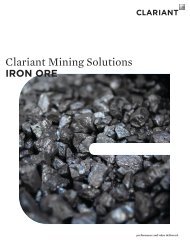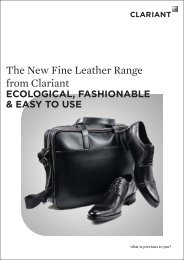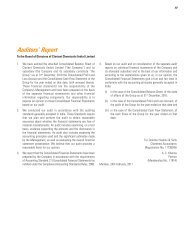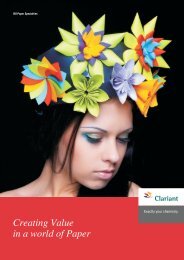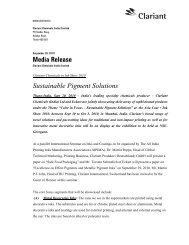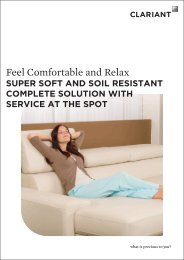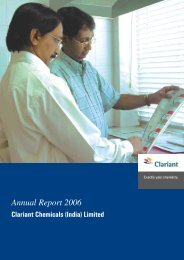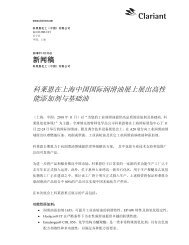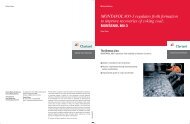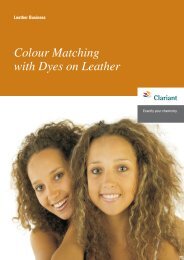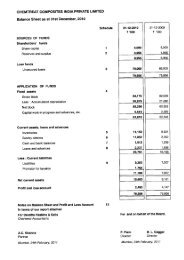Colour Chronicle - Sept 2012 - Clariant
Colour Chronicle - Sept 2012 - Clariant
Colour Chronicle - Sept 2012 - Clariant
You also want an ePaper? Increase the reach of your titles
YUMPU automatically turns print PDFs into web optimized ePapers that Google loves.
textile<br />
Orange and scarlet shades<br />
Golden Yellow HF-CD<br />
Scarlet HF-3G<br />
Red HF-3B<br />
What are the main problems faced by the<br />
continuous dyer?<br />
Shade transfer from lab to production.<br />
Shade reproducibility from batch to<br />
batch in production.<br />
Meeting modern retailer and brand<br />
house fastness requirements.<br />
Shade reproducibility from batch to batch<br />
in production.<br />
What are the main issues faced by the<br />
continuous dyer?<br />
Fabric appearance, penetration and<br />
levelling.<br />
Dyestuff solubility.<br />
Face to back shade variation (emerized<br />
fabrics).<br />
Shade continuity along the length and<br />
width of the fabric (tailing/listing).<br />
Dyestuff migration during pre-drying.<br />
Dyestuff stability to alkaline hydrolysis.<br />
Washing off and wet fastness.<br />
Photochromism.<br />
Fastness properties of the individual<br />
dyestuff.<br />
Improving fabric appearance, penetration<br />
and levelling with Drimaren ® HF dyes.<br />
Dyestuffs with high diffusion are essential<br />
for:<br />
Tightly woven fabrics.<br />
Fabrics constructed from high twist<br />
yarns.<br />
Mercerized fabrics.<br />
Regenerated cellulose, linen and<br />
cellulosic blends (CO:CV, CO:FL).<br />
Emerized fabrics (to improve face to<br />
back shade difference).<br />
Dyestuff stability to alkaline hydrolysis<br />
What can be done to minimize alkaline<br />
hydrolysis?<br />
Automatic liquor dosing systems (ratio<br />
4:1).<br />
Low volume economizer trough (fast<br />
pad liquor turnover time).<br />
Increase the amount of sodium silicate<br />
in the pad batch process (70 ml/l /<br />
38°Bé).<br />
Control of the fixation time and<br />
temperature.<br />
Control of the washing off conditions<br />
(mono VS dyes sensitive to alkaline<br />
washing).<br />
Cooling cylinders are used to cool and<br />
level out the fabric temperature before<br />
padding.<br />
Cooling water jackets around the pad<br />
trough are used to maintain the desired<br />
pad liquor temperature.<br />
Process water cooling systems for<br />
preparation of the dye and alkali<br />
solutions.<br />
Use reactive dyestuffs with high<br />
alkaline stability.<br />
Washing off reactive dyes<br />
Excellent wash and wet fastness properties<br />
can only be achieved by complete removal<br />
of the hydrolyzed dye, alkali and auxiliary<br />
chemicals during a washing off process.<br />
Very high fixation values.<br />
A high level of fixation is essential for<br />
good shade reproducibility, easier washing<br />
out of the unfixed dye and to minimize<br />
the amount of color that passes into the<br />
effluent.<br />
Brill. Yellow HF-RL .................. 96%<br />
Golden Yellow HF-CD ............... 96%<br />
Yellow HF-CD ............................. 92%<br />
Red HF-CD ................................. 90%<br />
Red HF-3B .................................. 97%<br />
Dark Red HF-CD ........................ 98%<br />
Aquamarine HF-CD .................. 90%<br />
Blue HF-RL ................................. 90%<br />
Dark Blue HF-CD ....................... 93%<br />
Royal Blue HF-CD ..................... 90%<br />
Navy HF-GN ............................... 95%<br />
Navy HF-B .................................. 97%<br />
Exchange Phase 1 > Diffusion & Desorption Phase > Exchange Phase 2<br />
10<br />
colour chronicle 3 | <strong>2012</strong>


